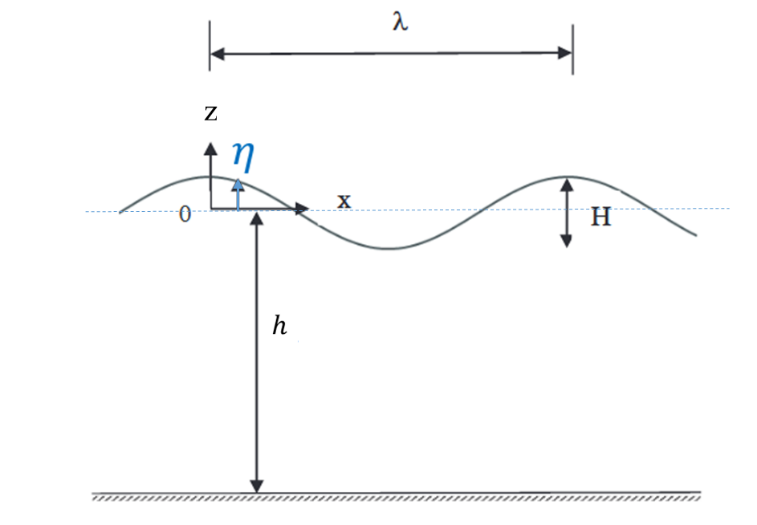1. Reference problem#
1.1. Geometry and boundary conditions#
The figure below represents the reference problem: a cylindrical cable immersed under the free surface in a column of water of height \(h=30m\). The ends of the beam are supported by two springs, which are themselves embedded at their ends.
Note \({S}_{w}\) the hydraulic section (seen by the fluid) transverse to the beam.

1.2. Material properties#
The material has an isotropic elastic behavior:
Young’s module |
\(200\mathit{GPa}\) |
Poisson’s Ratio |
\(0.3\) |
Cable density \(\mathrm{\rho }\) |
|
Water density \({\mathrm{\rho }}_{w}\) |
|
Spring stiffness according to x, y and z |
\(50.0N/m\) |
Drag coefficient \({C}_{d}\) |
|
1.3. Wave kinematics#
We consider a regular monodirectional swell directed along the \(+x\) axis, of order 1 (Airy swell), of height \(H\), of period \(T\) and of wavelength \(\mathrm{\lambda }\), see diagram below.

The free surface \(\mathrm{\eta }\) as a function of space \(x\) and time \(t\) is expressed:
with \(k=\frac{2\mathrm{\pi }}{\mathrm{\lambda }}\) the wave number and \(\mathrm{\omega }=\frac{2\mathrm{\pi }}{T}\) the pulsation.
The speed of fluid \({V}_{w}=(u,v,w)\) is as follows:
The acceleration of the fluid is noted \({a}_{w}=\frac{\partial {v}_{w}}{\partial t}\).
1.4. Loads#
The cable is subject to drag forces induced by a field of regular waves of height \(H=3m\) and period \(T=12s\).
Note that Archimedes” weight and thrust are not taken into account in this problem.
Modeling A
The cable is subject to Morison’s efforts (drag term only):
where \({v}_{w}\) and \({v}_{s}\) respectively designate the fluid speed and the solid speed (mechanical load input parameter FORCE_POUTRE). The symbol \(\text{ortho}\) represents the projection in the direction normal to the neutral fiber of the beam [1] _ . It should be noted that these are linear forces that are applied in a distributed manner on the beam.
Note: Morison’s efforts depend on the position of the beam; they should be mentioned as follower loadings in the calculations.